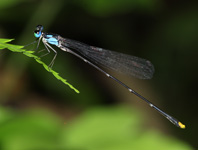Abstract
Taeniopteryx araneoides Klápalek, 1902, a stonefly species with brachypterous males, known historically from the Danube, Elbe, and Dniester rivers, but considered to be extinct at least in Europe for more than a century. This species has also been doubtfully reported from Krasnoyarsk, Central Siberia. However, we report this species to be still thriving in the Irtysh River at the cities of Omsk (West Siberia, Russia) and Pavlodar (North Kazakhstan). The occurrence of this species reported least fifty years ago from the Yenisey River at Krasnoyarsk, Russia is considered possible. Unlike the widespread Palaearctic T. nebulosa (Linnaeus, 1758) that occurs in a broad range of stream types, T. araneoides is a potomon species, apparently confined to large rivers. In this habitat, it appears vulnerable to anthropogenic impacts and may be unable to compete with T. nebulosa. The construction of dams and reservoirs has apparently extirpated T. araneoides from most of its former geographical range.
References
Aubert, J. (1966) Notes sur quelques Plécoptères du Muséum d’Historie Naturelle de Budapest. Annales historico-naturales Musei nationalis hungarici, 58, 285–288.
Bianchi, Y.L. (1905) Vesnyanki Plecoptera. In: Jacobson, G.G. & Bianchi, Y.L. (Ed.), Orthoptera and Pseudoneuroptera from the Russian Empire and neighbouring lands. A.F. De Vriena Publ., St-Petersburg, pp. 502–634. [in Russian]
Devyatkov, V.I. (2002) Pervye svedeniya po faune (Insecta: Plecoptera) basseyna verkhnego Irtysha. Zoologicheskie issledovaniya v Kazakhstane: sostoyaniye i perspektivy (proceedings of international conference), Almaty, 2002, 225–227. [in Russian]
Diakiv, K. (2011) Fauna of stoneflies (Insecta, Plecoptera) of the Ukrainian Carpathians. Naukovi zapiski Ternopol’skigo Natsional’nigo Pedagogichnigo Universitetu, Seriya: Biologiya, 48 (3), 62–69. [in Ukrainian, Russian and English summary]
Fochetti, R., Manuel, De Figueroa, J.M.T. (2006) Notes on diversity and conservation of the European fauna of Plecoptera (Insecta). Journal of Natural History, 40 (41–43), 2361–2369.
https://doi.org/10.1080/00222930601051386Klpalek, F. (1902) Zur Kenntniss der Neuropteroiden von Ungarn, Bosnien und Herzegovina. Természetrajzi Fusetek, 25, 161–180.
Klpalek, F. (1905) Conspectus Plecopterorum Bohemiae. Casopis Ceskoslovensk Spolnecnosti Entomologick, 2, 27–32.
Kovcs, T. & Murányi, D. (2008) Taeniopterygidae Klápalek, 1905 species in Hungary (Plecoptera). Folio historico naturalia musei matraensis, 32, 103–113.
Stewart, K.W., Szczytko, S.W. & Maketon, M. (1988) Drumming as a behavioral line of evidence for delineating species in the genera Isoperla, Pteronarcys, and Taeniopteryx (Plecoptera). Annals of the Entomological Society of America, 81 (4), 689–699.
https://doi.org/10.1093/aesa/81.4.689Zaika, V.V. (2011) The stoneflies (Insecta, Ectognatha, Plecoptera) of Maliy Enisey River (Tyva). Euroasian Entomological Journal, 10 (1), 10–14. [in Russian, English summary]
Zapekina-Dulkeit, Y.I. (1957) Vesnyanki Altae-Sayanskikh gornotaezhnykh vodoemov. In: Abstracts of a conference of zoologists of Siberia. AN SSSR, Novosibirsk, pp. 27–28. [in Russian]
Zapekina-Dulkeit, Y.I. (1971a) Dopolnenie k faune vesnyanok (Plecoptera) zapovednika “Stolby i smezhnykh territoriy. Trudy gosudarstvennogo zapovednika “Stolby, 8, 88–90 [in Russian]
Zapekina-Dulkeit, Y.I. (1971b) Vesnyanki (Plecoptera) Sibiri. TXIII International Congress of Entomology, Moscow, 2–9 August, Abstracts, 1, 223–224. [in Russian]
Zhiltzova, L.A. (2003) Insecta Plecoptera. Plecoptera, Gruppe Euholognatha. Fauna of Russia and Neighbouring Countries, New Series, 145, 1–538. [in Russian, English/German title]
Zwick, P. (1973) Insecta: Plecoptera. Phylogenetisches System und Katalog. Das Tierreich. Eine Zusammenstellung und Kennzeichnung der rezenten Tierformen, 94, 1–465.
Zwick, P. (1992) Stream habitat fragmentation – a threat to biodiversity. Biodiversity and Conservation, 1, 80–97.
https://doi.org/10.1007/BF00731036Zwick, P. (1999) Historische Dokumente zur Fauna de Elbe bei Dresden von hundret Jahren. Lauterbornia, 37, 97–112.
Zwick, P. (2004) Key to the West Palearctic genera of stoneflies (Plecoptera) in the larval stage. Limnologica, 34, 315–348.
https://doi.org/10.1016/S0075-9511(04)80004-5

